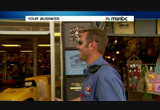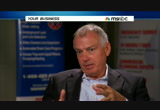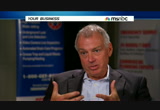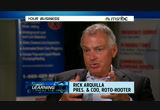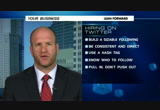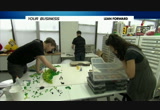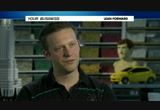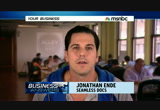tv Your Business MSNBC August 31, 2013 2:30am-3:01am PDT
2:30 am
an iconic boardwalk amusement park in ocean city, maryland. across the country, many of these have shut down. how has this one able to survive for more than a century? well, we'll tell you. that's coming up next on "your business." small businesses are revitalizing the economy and american express open is here to help. we're proud to present "your
2:31 am
business" on msnbc. hi, everyone, i'm j.j. ramberg, and welcome to "your business" where every week we gather together to talk entrepreneurship and give you tips, advice and a little inspiration to help your small business grow. for more than 100 years, the family has run an amusement company on the boardwalk of ocean city, maryland. i went down to spend a summer day with the trimpers to find out the trick to surviving through so many generations and running a decidedly old school business in today's modern world. >> for brooks and christopher and their aunt stephanie, taking over on the boardwalk in ocean city, maryland, was as much
2:32 am
destiny as choice. >> it's what we do. we don't really know any different. >> my grandfather called and wanted me to come be involved in the family business. >> the boardwalk is my heart and soul. >> the company was founded in 1890 by daniel trimper who visited from baltimore and never left. >> amusements, arcades, mini golf, tank battle. >> today it includes an amusement park, arcade, games, restaurants, and other attractions. as the ocean city boardwalk grew over the last century, so did the company. from here, all the way to the end, this is all trimper. >> yes, and the fifth generation to take the reins, the great, great grandson of the founder. >> you're 33 years old, so you're one of the youngest. >> yes. >> of the dynasty here. and yet you're the one in charge. how did that happen?
2:33 am
you're the chairman. >> in family business, there's a lot of drama and politics. >> from the perspective of any thrill seeker looking to hop on to the freakout or someone looking to win a big stuffed animal at the horse race, it all looks easy. fun and games really. but to brooks and his family, running this business is anything but. the family drama is just the start. >> and there's probably approximately 25 stockholders and, you know, those stockholders have children and spouses and things. there's quite a few people that have some sort of ownership of this place. >> ownership and different ideas of how things should be run. >> i've got a lot of extended family that have a lot of needs and desires and they want to get return on their investment, which is understandable, everyone does. so being natural core family that runs it, i feel that my grandfather left us with that responsibility. not only do we need to provide an amusement park for the people of ocean city, but provide a
2:34 am
return for our shareholders. >> a return that is increasingly tough to provide. taxes have gone up, the cost of maintaining the rides has increased. and prices, they can't go up too much. >> we can't pass -- like most businesses can pass their expenses on to the consumer. it's very hard here because a parent can only afford so much, you know, for a child to ride a ride for three minutes. >> it used to be 10-cent ski ball and the public almost died when i had to switch it to a quarter. >> this place has history and because of that, it's hard to change almost anything. it took brooks and christopher an entire year to get their grandfather to start accepting credit cards. >> there's a lot of people stuck in their ways. and 100 years, it doesn't matter if a new policy comes out, this is how we did it for 88 years. >> one thing we talk about small businesses, they're nimble, they can make decisions and act on them quickly. sounds like in this small business you don't have that.
2:35 am
>> no, we've been there so long, so many stockholders. to make a decision, you need to make sure you speak to everybody. >> and in a business that has so much nostalgia attached to it, it's not just the shareholders but also the customers who have been coming for generations. >> if we can no longer get parts from it or no longer profitable, we get complaints. oh, my kids love those boats. >> brooks says his company is decidedly old school, pretty much by definition. but they're committed to keeping it alive. and so are working with their board to make the changes needed to have an old-school amusement business survive in this modern world. a clear example is the arcade, marty's play land. >> the biggest change is the prizes that kids want. so, you know, now we've got video games with ipads and
2:36 am
itouches. >> i can win an ipad or itouch? >> from playing games. >> that is different from when i was a kid. >> yeah. >> while the prizes may change and the rides may get a little scarier to attract the teenagers, the trimpers are dedicated to keeping this amusement park true to the park they grew up with it. >> i find it interesting you've been playing this and running this game since you were 8 years old, and yet i'm beating you. >> not yet. you're distracting me. >> and there'll be another round of trimpers running this in the next generation. >> the land your business is on is worth a lot of money, marty's playland, is it ever tempting for you to sell it? >> i can't say that people haven't thought about it. i would never trade out our heritage on this boardwalk because it means too much. i would want to be here every day anyway and i wouldn't want it to be somebody else's. >> not even for a payout?
2:37 am
>> not even for a payout. i'm here for the long haul. a household name since 1935, the company was built around the invention of the roto rooter machine, the first electric sewer cleaning device. the company's grown into the largest provider of plumbing, repair and sewer cleaning services in the u.s. how have they survived and grown the business for more than 75 years? ♪ roto rooter that's the name ♪ >> there's only two modes, growing or dying. growing is easy to see. sales are up, profits are up. i think often times when companies begin to what i call the slow death march, there's
2:38 am
too much rationalization. there's too much, it was just a blip on the screen. oh, it's just a couple of bad years. roto rooter is a rare example, something conceived in 1935 and still going strong in 2013. most brands don't last that long. where do brands get themselves in trouble? well, they go past prime. there's not much market share or growth left. and instead of reinventing themselves, they say let's work harder next year. let's trim some costs. but unless you find a way to reinvent yourself, find new services or products, you're on a slow death march and you're in denial. you have employees that are counting on you not to do that. and if you're past prime, own up to it and start making the right decisions because you'll either grow or start dying. you've hit on a good idea and everybody in the company gets in line and wants to do it. and the energy level's off the
2:39 am
charts. we've got to slow down because if we outrun our headlights, if we roll something out too quickly, then the collateral damage could kill the concept. so i think you have to slow down enough and have the discipline to say if this is a good concept, if no one else is doing it, we've probably got a little time to tweak and figure out what's working, what's not. and if we're entering a new business that others are already in, what's the rush. get it right. because if you outrun your headlights, it's dark out there. you might get off the road or worse. it's important, i think, to understand the difference between leveraging your business and reinventing your business. leverage is simply how do i grow sales a little bit more with the product service package that i have today. how do i control expenses maybe a little better than i have
2:40 am
historically. but leverage just gives you a little more upside. reinvention, though, is exponential, that's where the big money is. that's also where the big losses could occur. i think there's no formula for this but everyone has to kind of do that gut check and say do i have some level of risk tolerance? and am i willing to try to take a portion of my profitability and leverage that into new businesses, product services that i'm presently not in? the time to reinvent is when it's going great, when you're growing, when you're winning, when you have the energy. and it's the hardest time to reinvent because your employees don't want to jump on board. saying, lighten up, boss, everything's great. you have to be the person who sees the trends developing before anyone else does. and it's harder when you're doing well to get the support of the organization. but if they trust that you have their interests and the
2:41 am
company's interests at heart, why you can afford to do it. when it comes to hiring, gone are the days of focusing only on resumes. today, smart businesses are also using social media tools like twitter to recruit as well as learn more about candidates. tom gamble is here to tell us how tweets can successfully lead to your next hire. he's the president and ceo of a chicago-based professional staffing and recruiting firm. great to see you. >> good to see you too, j.j. >> it can be used for so many things. and it's interesting, you're going to talk about how it's both for recruiting people but also doing a little research on them. let's dig into this. if you want to use twitter, first you have to build a following. >> yeah, it's all about how many followers you have and when you post something else on someone's twitter feed and how you can go viral with that. you have to be more than just 10, 15, 20 followers.
2:42 am
can't be something you use for your friends on a social basis or reuniting with college folks. if you really want to use twitter effectively from a professional business standpoint, you've got to get a lot of followers. >> are you supposed to be having a special twitter handle for recruiting? or do you use your company's? >> that's the age old problem with social media. going back a few years ago with facebook and people getting job offers rescinded because of crazy pictures. you have to decide what you want your twitter handle to be used for. what we try to advise ours, that want to attract people. use it professionally. you can do personal posts, make sure they're not too far out there in left field. on the flip side, if you're a candidate and looking for a job, realize that people are looking at you from all different angles in the social media world and keep it fairly tight. >> be consistent and direct, you mean with your messaging about the jobs? >> yeah, across all things.
2:43 am
if you're going to be concise and direct about what your company's doing, you want to be able to -- you want to use hashtags, number one, and reference back to something. a lot of people are afraid of twitter, it is still new. there are people who don't understand. okay, if i put a hashtag in, how does that trace back to me? >> so, say, for instance, i'm at a coffee shop and jj's coffee looking to hire a baris barista #jobopen. >> #jobopen, who knows, wherever your demographics are. >> and know who to follow. if you are using twitter to hire people, what kinds of people do you want to follow? >> well, i think it really depends on the business. and where you want to go to get people. at the end of the day, what you want to have is your post be
2:44 am
retweeted. sometimes you can think about it too much and get too analytical as to who you're following. you want to be followed by a lot of people and have your posts retweeted so it gets out. it's the old commercial where it goes from four to eight to 16 to 32, it multiplies. >> you might want somebody who has a lot of followers in that world. >> absolutely. but also might be somebody to follow you, j.j., if there's a lot of people in the business community that are following your posts and i write something and you retweet that, it's going to hit people in a different way. and while you're in the business community you're not directly in financial services. >> pull in, don't push out, what does that mean? >> you don't want to be selective with what you're doing. twitter is one avenue for people to find other people and also to find jobs. you want to bring as many people as you can into your world and then have to screen out. and so when you get too selective and only want to follow people working at banks
2:45 am
or private equity firms, you're really limiting -- >> or coffee shops, only going after college grads, you're limiting yourself. it is a numbers game. >> i know hiring, i talked to small business owners across the board, one of the top three things they're having trouble with in spite of unemployment numbers is hiring. >> it isn't as bad out there as it looks. still ahead, more information and advice to help your small business grow. we'll answer some of your questions about building a sales force and keeping them motivated. and shawn kenny loved legos, so he turned his hobby in what's become a booming business. building animatronics is all about getting things to work together. the timing, the actions,
2:46 am
the reactions. everything has to synch up. my expenses are no different. receipt match from american express synchronizes your business expenses. just shoot your business card receipts and they're automatically matched up with the charges on your online statement. i'm john kaplan and i'm a member of a synchronized world. this is what membership is. this is what membership does. shawn kenny loved to play with lego blocks. he would spend time making sculptures and other creations out of them. what used to be a hobby for shawn has become a booming business. his work has been bought by major corporations. it's been exhibited around the world and items like his lego lamps can be bought on sites like fab.com. here's how sean turned his play into profits.
2:47 am
you could say sean kenny has a unique business. >> i did a project for the philadelphia zoo and we built 30 life-size animals set up all around the zoo. the polar bear took 1,100 hours to build and it had over 95,000 pieces in it. >> he's a lego certified professional. that's right, he actually has an official certification to play with lego blocks. >> the wall you're looking at now is probably about 300,000 pieces although only a small portion of the 1.5 million i have here in the studio. >> just across the river in manhattan, he's built a company out of a childhood passion. but this wasn't his first profession. for years, he worked in technology in the financial sector while satisfying his hobby outside the office. >> i would take pictures of my creations and put them up online. there's a lot of people that actually play with lego toys as an adult as a hobby and i was
2:48 am
one of many of them. >> elaborate designs such as this one helped him build a reputation. and the right people started to take notice. >> one day, i got an e-mail from the lego company. hey, we're going to be coming to the city, we'd like you to come along and bring this model and that thing and the other thing you made. >> he set out on his own and formed sean kenny design. >> we said, let's come up with a way they can support what i do and it eventually became what's now lego certified professionals. >> sean operates independently of lego, but partners with the company to work on displays and special events. the connection was a great way for him to get his work in front of people and also legitimize an unusual business. >> i have an operation here, facility, staff, this is a real thing. >> despite doing almost no traditional marketing, he's landed commissions for corporate
2:49 am
giants like google and mazda, individual clients, and other quirky jobs. >> i was contacted by the staff at "30 rock" because tina fey had written in her show they assembled a lego train as part of a training seminar. >> it's a smokestack. >> and then they realized they needed one for a prop and called me. there was a gallery putting together an exhibit all about william shatner. i call this plastic shatner. >> these projects have combined to give his business a great deal of flexibility. >> you never necessarily know who is going to come and ask you to do things. i've, you know, developed sort of static revenue streams for things such as my books so that i know i can sort of structure the rest of my business around other things. >> looking back, sean, doesn't point to a single tipping point but rather a steady build-up similar to the way one of his creations comes together. >> a lot of businesses are about
2:50 am
grow, grow, grow. is last quarter better than the quarter before that? but i'm happy knowing if i can run my business, be successful, make enough money to raise a family and live in this expensive city i live in, i'm going to be really happy. it's time now to answer some of your business questions. let's turn to our board of directors for their expertise. the founder and ceo of retro fitness. he's also launched a second company, it's called let's yo yogurt. and an advisory firm that helps executives understand how well their sales forces are performing. now, the first question, great to see both of you guys, is about selling your brand. >> i would be curious if there were any recommendations on how to build an enterprise sales force internationally and externally. >> greg, this is sort of made for you. how do you build your sales force?
2:51 am
>> i would start with understanding how the customer makes a purchase decision and what their critical touch points are along the way. literally at the deal level and account level. and working backwards from that, i would understand how to serve the customer at those critical moments, determine what kind of salesperson that i need. determine whether or not the contact needs to be virtual contact or face-to-face contact. determine a work load capacity, how often do i need to call on that person, determine how many salespeople i need. determine the type of tools i would need to meet those particular customer needs. >> it's hard. i've hired salespeople before and i do not have a background in sales. and i'll be honest, i did not a great job hiring the person and then not giving them the tools they needed to be successful. it's hard to find people who are as passionate as you are about what you do. so eric, how do you get the right fit? >> i think that's going to be critical.
2:52 am
if you're talking about sales, sales isn't always the product, it's the person, someone's not buying the product, they're buying you. you hire a salesperson, you're interviewing in my assessment for the personality, the quality and skills. when they're presenting to one of your customers or potential customers, they're going to be buying that person's personality in how they present your product. >> how do you find that person? >> it's a needle in a haystack. we talk about mining for diamonds all the time. you've got to sift through a lot of coal to get to the diamond. in our system, we talk about selling franchises as opposed to gym memberships. we're looking for a person, though. that personality, that enthusiasm, they've got to have a lot of passion and that ability to want to work and put their enthusiasm around the clock into your business. >> well, i'm glad someone asked this question, i'm going out to california next week to do a story on this next week. let's move on to the next question. this is about expanding your network. >> what is the best way to reach
2:53 am
out to potential clients that through contacts you may not have and find people at companies you want to reach out to? >> this is hard, right? cold calls are some of the hardest things to do. is there a good way when you don't have a pre-existing relationship or a friend of a friend? >> the new version to dave's version of cold calling is linkedin. i get hit up on linkedin all the time. it's difficult to get me on the phone in my office. 92 people plus my assistant then you get me. i'm going to read that e-mail because i'm screening that. now it's being creative with how you get to the decisionmaker. >> this is a question about keeping your all-important sales staff motivated. >> i'd ask for tips on their strategies where they've grown from a small start-up like five people to a large company with a long sales cycle. >> the way to keep a sales rep
2:54 am
engaged during a sales cycle is a technique called sales gamefication. make a game of it. there are steps along the way that can be small victories. maybe a silver rep, bronze rep, gold rep along the way. keep them interested by gamefying it. >> it's also, you have a timing effect. maybe one's coming in and closing from six months ago -- but until you get to the point where they have the built-up pipeline, keeping them motivated is all about them understanding what the end goal is, what the end result is. and like greg said, along the way, there's merits along the way. there's little steps along the way. hey, this is great. what's the next step? we've got to come in for a discovery day so they can learn and meet the team. once those things happen, there are positive things along the way you can reward and maybe not a financial compensation, but like greg was saying, some kind
2:55 am
of merit badge or encouragement tool. hey, let's celebrate over xyz. >> greg, how do you figure out the right balance between commission and salary? >> well, depends on the economics of your sale. if you're selling a big-ticket item, you can afford a salary and hang in there. but if you're in a transactional sale, it's a small dollar amount, the gross margin might be tighter and you want to go with more commissions. >> let's say you're giving commissions, higher commissions, a lot of these salespeople are selling a lot of products. how do you keep them excited about your product? >> in our environment, again, i love a salesperson that sits across from me that says pay me commission. i know that's a go getter. you've got to love that guy or gal. but for us, it's the enthusiasm. your carrot's got to be the biggest carrot that's going to be hanging out there.
2:56 am
if you're going to be using some kind of independent contracting sales tools. we have something internal in our sales organizations. but we do know there are companies that use these floating devices that are out there. i'm not a big fan of those. i like my team to be internal. >> thank you, guys, so much, eric and greg, for coming on. i think hiring a sales team is so incredibly important and tricky. tricky how to keep them motivated. i appreciate your insight on all of this. and if you have a question for our experts, go to our website, the address is openforum.com/yourbusiness. once you get there, hit the ask the show link to submit a question for our panel. again, that website is openforum.com/yourbusiness. or if you'd rather, you can e-mail us your questions or comments, yourbusiness@msnbc.com. in today's technology-driven mobile world, snagging more customers doesn't have to be
2:57 am
tedious or expensive. here now are five simple ways to find more online leads and customers courtesy of ysf magazine. one, webinars. a great low-risk, low-cost way to share valuable information with potential customers and build your e-mail subscriber data base quickly. two, pay for click ads. these advertisements can help you strategically bring your target audience to your website. three, content marketing. infographics, how to guides and blogs are way to post useful materials. this helps more customers learn about you and build back links to bring more traffic to your site. four, mobile optimization. it's estimated that nearly 35% of all web traffic comes from a mobile device. make sure you have an accessible, mobile friendly version of your company website. and five, public relations.
2:58 am
newsworthy pr announcements can help with generating media coverage and keeping your company's website ranking higher within the search engines. looking to get your business information and offerings in front of more customers? well, check out our website of the week. provides an easy to use online dash board to manage your price list, menu, services all from one place. you can automatically update your listings on websites like yelp and trip advisers and the yellow pages. the site allows you to promote and share any changes on social media sites like four square and trip adviser. thanks so much for joining me today. i hope you learned a thing or two. you can find all of today's segments online, as well. go to openforum.com/yourbusiness. we also put up some web exclusive content for more information to help your business grow. we're on twitter, as we well @yourbiz. and don't forget to become a fan of the show on facebook.
2:59 am
next time, americans and their concerns about safety have spawned the movement. and entrepreneurs have moved in to serve that constituency. >> our demographic is people who want to be able to be comfortable and survive if there's an emergency. >> how fear of the unknown and the need to get control is driving the profits of small businesses catering to survivalists. until then, i'm j.j. ramberg. and remember, we make your business our business. building animatronics is all about getting things to work together. the timing, the actions, the reactions. everything has to synch up. my expenses are no different. receipt match from american express synchronizes your business expenses. just shoot your business card receipts and they're automatically matched up with the charges
3:00 am
on your online statement. i'm john kaplan and i'm a member of a synchronized world. this is what membership is. this is what membership does. a strike seems all but assured after the secretary of state john kerry came before the nation today with a stunningly aggressive case for military intervention in syria. he he began with what he called the facts about the chemical weapons attack that took place near damascus last week.
93 Views
IN COLLECTIONS
MSNBC West Television Archive
Television Archive  Television Archive News Search Service
Television Archive News Search Service 
Uploaded by TV Archive on

 Live Music Archive
Live Music Archive Librivox Free Audio
Librivox Free Audio Metropolitan Museum
Metropolitan Museum Cleveland Museum of Art
Cleveland Museum of Art Internet Arcade
Internet Arcade Console Living Room
Console Living Room Books to Borrow
Books to Borrow Open Library
Open Library TV News
TV News Understanding 9/11
Understanding 9/11


